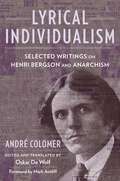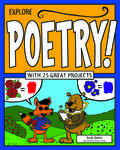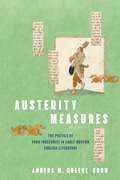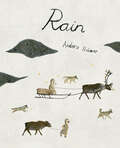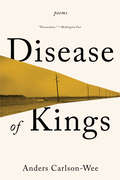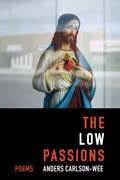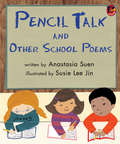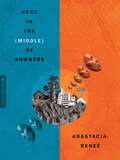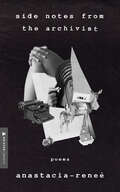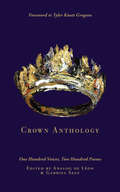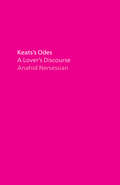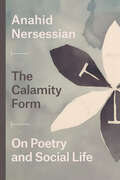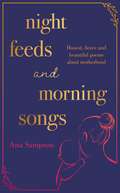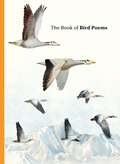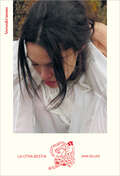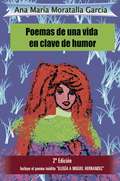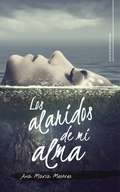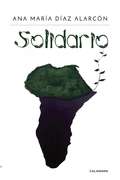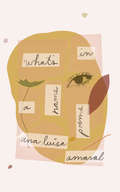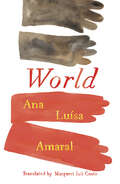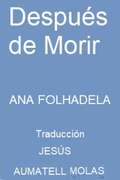- Table View
- List View
Lyrical Individualism: Selected Writings on Henri Bergson and Anarchism (Columbia Themes in Philosophy, Social Criticism, and the Arts)
by Andre ColomerIn the early twentieth century, André Colomer was perhaps the best-known figure in the anarchist movement. A poet, philosopher, activist, and public speaker, he was enmeshed in the Parisian political and artistic scene at a time of political and cultural revolution. Amid the avant-garde explosions of Cubism, futurism, and surrealism and the ferment of radical politics on left and right, Colomer became anarchism’s leading advocate. He galvanized the Parisian public through his agitational writing and organizing, as well as his involvement in a sensational murder case, while developing a distinctive philosophical account of anarchist individualism. Yet Colomer died in obscurity in Moscow, abandoned by his friends and comrades, and is scarcely known in the English-speaking world today.Lyrical Individualism presents a selection of Colomer’s crucial writings, with a focus on anarchist theory and the philosophy of Henri Bergson. It reveals the richness of Colomer’s philosophical work, particularly his creative engagement with Bergson, Max Stirner, and Friedrich Nietzsche to forge a novel anarchist ideology. Colomer’s writings not only offer valuable insights into interwar anarchism, they also present a distinctive philosophical vision that in many ways anticipates theories and debates animating radical political movements today. This book also showcases his acerbic and pugnacious political commentary on the turbulent events of the 1910s and 1920s. The first translation and publication of Colomer’s work since his untimely death in 1931, Lyrical Individualism allows a range of readers to discover this vital thinker.
Explore Poetry!
by Andi DiehnPoems can be silly, serious, or fun, just like kids! Whether it’s the sing-song rhythm of a limerick, the serendipitous magic of a found poem, the deceptive simplicity of a haiku, or the easy familiarity of an acrostic poem, children are charmed by poetry. And what’s more fun than reading poetry? Writing it! In Explore Poetry! With 25 Great Projects children have fun learning about different forms of poetry while delving into different literary techniques such as personification, metaphor, and alliteration, all of which are discussed in a simple and accessible way. Activities include creative writing exercises designed to reinforce language arts skills, plus art projects that encourage children to visualize concepts and definitions. Short biographies of important poets reinforce the concept of poetry as an important part of society. Explore Poetry! meets Common Core State Standards for language arts; Guided Reading Levels and Lexile measurements indicate grade level and text complexity. Informational and inspiring, Explore Poetry! fits seamlessly into the poetry curriculum of grades 2 to 4 and serves as an enrichment resource all during the school year, especially April, Poetry Month.
Austerity Measures: The Poetics of Food Insecurity in Early Modern English Literature
by Anders M. Greene-CrowExplores how early modern writers used poetry to fight food insecurityAusterity Measures explores how early modern writers used poetic form as a tool to fight extreme food insecurity. Authors such as Thomas Tusser, George Herbert, Robert Herrick, Anne Bradstreet, and Thomas Tryon witnessed the privatization of public farmland, rising food prices amidst uncontrolled inflation, mass starvation in nascent North American colonies, and the racist violence of the Caribbean plantation slavery system. Anders M. Greene-Crow shows how these authors experimented with literary form in an effort to change readers’ beliefs and behaviors with regard to food ethics.By examining this history, Greene-Crow sheds new light on both modern-day food ethics and activism’s place in literary writing. This book traces how authors’ solutions to food insecurity turned away from structural models of communal care and toward the now-dominant consumer-capitalist model championing individual dietary choice. Simultaneously, he reveals why literary criticism began to discount literature’s power as a tool for social change. The New Critical school, whose close reading methodology dominates literary analysis, arose out of Southern Agrarianism, a movement that sought to return the South to antebellum structures of racial hierarchy and labor exploitation that took shape in the early modern period. These intersectional labor politics underlie close reading, continuing to limit critics’ understanding of how literary form produces social change, and reinforcing the scarcity culture of literature departments today.By recovering poetry’s role as a force for affecting readers’ relationship to one of their most basic needs—the need to eat—Austerity Measures develops an alternative methodology that takes writers’ material conditions into account in analyzing form.
Rain
by Anders HolmerA poetry collection celebrating the wonders of the natural world This haiku collection will enchant both nature lovers and budding poets. The spare, lyrical text describes a series of short vignettes, each of them taking place in a different kind of rain, from thunderstorms to falling flower petals. The poems—some serious, some gently humorous—depict scenes from all over the globe: a horse struggling to plow a field, a father changing a tire while his children play, and two friends making up after a fight. With its majestic artwork, this introduction to a classic poetic form will inspire readers to write their own haiku as they experience the amazing world around them.
Disease of Kings: Poems
by Anders Carlson-Wee“Provocative.” —Washington Post A vivid chronicle of friendship and loneliness amid the precarity of life in late capitalism, when every day is a fight for survival. In poems bursting with narrative power, Disease of Kings explores the tender yet volatile friendship between two young scammers living off the fat of society. Here are stories of an odd couple who scrounge, con, hustle, and steal, alternately proud of their ability to fabricate a life at the margins and ashamed of their own laziness and greed. Rich with a specificity of voices, these poems locate themselves in a midwestern city at once gritty with reality and achingly anonymous. Here, the central speaker and his best—only—friend, North, come together and apart, nursing a sense of freedom that is fraught with codependence and isolation. With plainspoken language and tremendous tonal range, Anders Carlson-Wee leads us into the heart of one friendship’s uneasy domesticity—a purgatory where, in this poet’s vision, it is possible for loss to give way to hope, lack to fulfillment, shame to gratitude.
The Low Passions: Poems
by Anders Carlson-WeeIn a knockout debut collection haunted by shame, violence, and the darkest of our human origins, Anders Carlson-Wee mines nourishment and holiness from our depths. Explosive and incantatory, The Low Passions traces the fringes of the American experiment through the eyes of a young drifter. Pathologically frugal, reckless, and vulnerable, the narrator of these viscerally compelling poems hops freight trains, hitchhikes, dumpster dives, and sleeps in the homes of total strangers, scavenging forgotten and hardscrabble places for tangible forms of faith. A range of strong-willed characters takes shape, amplified by a chorus of monologues from the strangers who shelter him and the family he’s left behind—each made manifest by the poet’s devoted ear and sensitive eye.
Andal's Nachiyar Thirumozhi
by AndalAndal was a 10th century Tamil poet who is revered as a saint in the southern parts of India. Infact, she is considered as one of the twelve Alvars (saints) and the only woman Alvar (saint) of Vaishnavism (a cult devoted to Lord Vishnu). After her first work known as Thiruppavai, this one, Nachiyar Thirumozhi is the second compilation by Andal consisting of 143 verses. Through this poem, she disclosed her passionate yearning for Lord Vishnu. These 143 verses are a part of the 4000 hyms of Nalayira Divya Prabandham and are organized in 14 segments, each one called a tirumozhi. The poems compiled by Andal in her teenage years, display a high level of literary and religious maturity.
Thiruppavai
by AndalPart of Naalayira thivvya prabantham, Thriuppavai is a collection of 30 songs sung by Andal in praise of the Lord Mahavishnu. These songs are sung typically in the Tamil month of marghazhi culminating in the pongal festival in the month of Thai. It is said that Andal merged one with God at the end of these thirty days.
Pencil Talk and Other School Poems
by Anastasia SuenSee what fun school can be… when you add some poetry! A simple school day is a lot more fun when you add a little poetry! Follow along for a fresh look at spelling tests, recess, music class and more, in this spirited collection of school day poems.
Here in the (Middle) of Nowhere
by Anastacia-ReneeIn this bold hybrid collection of poetry, flash fiction, and Afrofuturism sci-fi, the award-winning interdisciplinary writer and author of Side Notes from the Archivist explores what happens when god is a Black woman in a town. What happens when there are multiple universes in the middle of nowhere?And what if in each universe there reigned other Black woman gods? One million versions of god, and one million saints to watch over us? And what if this Black woman god were placed here on earth?These are just a few of the questions Anastacia-Reneé asks in this daring and mind-bending hybrid collection. Hers is a universe of striking variety—monsters, nontraditional saints, witches, zombies, the couple in the apartment next door, the wise elders from down the block, and gods watching over us all—as well as community and connectedness.With a prose storyline and characters that connect through family, time, and place, Anastacia-Reneé paints world(s) rich with wonder and the paranormal as she peers into the lives of everyday people and spectacular creatures inhabiting not just our neighborhoods, but other dimensions. Here in the (Middle) of Nowhere is about interstellar ancestry, community and spirituality. It is about the things we invoke, conjure, and rely on to maintain joy as we keep it moving through difficult eras. Anastacia-Reneé’s power imbues her spellbinding storytelling with lovingly rendered characters brought to life in lyrical poetry. She builds worlds within worlds and dares us to fully see and love ourselves in all our complexity.
Side Notes from the Archivist: Poems
by Anastacia-ReneeThe award-winning, genre-crossing writer demonstrates her power as a funkadelic and formidable feminist voice in this rich and beautiful collection of verse and image—a multi-part retrospective that traverses time, space, and reality to illuminate the expansiveness of Black femme lives.Side Notes from the Archivist is a preservation of Black culture viewed through a feminist lens. The Archivist leads readers through poems that epitomize youthful renditions of a Black girl coming of age in Philadelphia’s pre-funk ’80s; episodic adventures of “the Black Girl” whose life is depicted through the white gaze; and selections of verse evincing affection for self and testimony to the magnificence within Black femme culture at-large.Every poem in Side Notes elevates and honestly illustrates the buoyancy of Blackness and the calamity of Black lives on earth. In her uniquely embracing and experimental style, Anastacia-Reneé documents these truths as celebrations of diverse subjects, from Solid Gold to halal hotdogs; as homages and reflections on iconic images, from Marsha P. Johnson to Aunt Jemima; and as critiques of systemic oppression forcing some to countdown their last heartbeat.From internet “Fame” to the toxicity of the white gaze, Side Notes from the Archivist cements Anastacia-Reneé role as a leading light in the womanist movement—an artist whose work is in conversation with advocates of Black culture and thought such as Audre Lorde, Amiri Baraka, and Nikki Giovanni.
Crown Anthology: One Hundred Voices, Two Hundred Poems (Lost Poets)
by Analog de Leon & Gabriel SageTwo hundred poems of hope and empowerment in a time of tumult and darkness, from Instagram’s Lost Poets community. Crown Anthology is a new collection of verse from an online subculture of poets, with a foreword by Tyler Knott Gregson, one of the movement’s foremost authors. By celebrating self-love, self-worth, and empowerment, these two hundred poems examine life in a dynamic and transformative poetry compilation that speaks soft words reminding us that every soul is royal. Featuring a beautifully diverse and inspirational set of voices from around the world, which includes some of today’s most influential modern poets with additional contest winners chosen from 4,500 submissions, Crown Anthology is curated to be a light in the wild dark, illuminating the crown that exists in everyone.
Crown Anthology: One Hundred Voices, Two Hundred Poems (Lost Poets)
by Analog de Leon & Gabriel SageTwo hundred poems of hope and empowerment in a time of tumult and darkness, from Instagram’s Lost Poets community. Crown Anthology is a new collection of verse from an online subculture of poets, with a foreword by Tyler Knott Gregson, one of the movement’s foremost authors. By celebrating self-love, self-worth, and empowerment, these two hundred poems examine life in a dynamic and transformative poetry compilation that speaks soft words reminding us that every soul is royal. Featuring a beautifully diverse and inspirational set of voices from around the world, which includes some of today’s most influential modern poets with additional contest winners chosen from 4,500 submissions, Crown Anthology is curated to be a light in the wild dark, illuminating the crown that exists in everyone.
Keats's Odes: A Lover's Discourse
by Anahid Nersessian“When I say this book is a love story, I mean it is about things that cannot be gotten over—like this world, and some of the people in it.” In 1819, the poet John Keats wrote six poems that would become known as the Great Odes. Some of them—“Ode to a Nightingale,” “To Autumn”—are among the most celebrated poems in the English language. Anahid Nersessian here collects and elucidates each of the odes and offers a meditative, personal essay in response to each, revealing why these poems still have so much to say to us, especially in a time of ongoing political crisis. Her Keats is an unflinching antagonist of modern life—of capitalism, of the British Empire, of the destruction of the planet—as well as a passionate idealist for whom every poem is a love poem. The book emerges from Nersessian’s lifelong attachment to Keats’s poetry; but more, it “is a love story: between me and Keats, and not just Keats.” Drawing on experiences from her own life, Nersessian celebrates Keats even as she grieves him and counts her own losses—and Nersessian, like Keats, has a passionate awareness of the reality of human suffering, but also a willingness to explore the possibility that the world, at least, could still be saved. Intimate and speculative, this brilliant mix of the poetic and the personal will find its home among the numerous fans of Keats’s enduring work.
The Calamity Form: On Poetry and Social Life
by Anahid NersessianRomanticism coincided with two major historical developments: the Industrial Revolution, and with it, a turning point in our relationship to the earth, its inhabitants, and its climate. Drawing on Marxism and philosophy of science, The Calamity Form shines new light on Romantic poetry, identifying a number of rhetorical tropes used by writers to underscore their very failure to make sense of our move to industrialization. Anahid Nersessian explores works by Friedrich Hölderlin, William Wordsworth, John Keats, and others to argue that as the human and ecological costs of industry became clear, Romantic poetry adopted formal strategies—among them parataxis, the setting of elements side by side in a manner suggestive of postindustrial dissonance, and apostrophe, here an address to an absent or vanishing natural environment—as it tried and failed to narrate the calamities of capitalism. These tropes reflect how Romantic authors took their bewilderment and turned it into a poetics: a theory of writing, reading, and understanding poetry as an eminently critical act. Throughout, Nersessian pushes back against recent attempts to see literature as a source of information on par with historical or scientific data, arguing instead for an irreducibility of poetic knowledge. Revealing the ways in which these Romantic works are of their time but not about it, The Calamity Form ultimately exposes the nature of poetry’s relationship to capital—and capital’s ability to hide how it works.
Night Feeds and Morning Songs: Honest, fierce and beautiful poems about motherhood
by Ana SampsonThe perfect gift for expectant mothers and new mums, whether it's her first baby or her fifth.'I read every single poem and wished that I'd had this book when I was pregnant, and feeding a baby, and watching her grow.' Sophie Heawood, author of The Hungover GamesA collection of honest, fierce and beautiful poems about being a mother, from pregnancy and birth to growing up and leaving home. Curated by acclaimed anthologist Ana Sampson, Night Feeds and Morning Songs examines motherhood from all angles, capturing the mess and the madness, to the joy and the wonder. Immerse yourself in classic verse from Carol Ann Duffy, Elizabeth Barrett Browning, Jackie Kay and Sylvia Path, to poems from bold new voices Kate Baer, Liz Berry, Nikita Gill and Imogen Russell Williams to name but a few.
The Book of Bird Poems
by Ana SampsonThe wonder of birds has charmed and inspired poets down the centuries and across the globe. From Shakespeare's 'feathr'd king' to Ted Hughes 'butterfly lightness', of swifts, this is a collection to stir the soul of any nature lover. Our emotional and cultural connection to the bird world is captured in 60 of the best-loved poems, which include the work of Percy Shelley, Edgar Allan Poe, Longfellow and Keats. All of them accompanied by the beautiful bird illustrations of Ryuto Miyake. From the common robin to the soaring eagle, from the chattering parrot to the sinister crow.This anthology will help us see our flighted cousins in a new light and confirm why they feature so much in our art, folklore and literature. They are indeed, poetry in motion.
The Book of Bird Poems
by Ana SampsonThe wonder of birds has charmed and inspired poets down the centuries and across the globe. From Shakespeare's 'feathr'd king' to Ted Hughes 'butterfly lightness', of swifts, this is a collection to stir the soul of any nature lover. Our emotional and cultural connection to the bird world is captured in 60 of the best-loved poems, which include the work of Percy Shelley, Edgar Allan Poe, Longfellow and Keats. All of them accompanied by the beautiful bird illustrations of Ryuto Miyake. From the common robin to the soaring eagle, from the chattering parrot to the sinister crow.This anthology will help us see our flighted cousins in a new light and confirm why they feature so much in our art, folklore and literature. They are indeed, poetry in motion.
La otra bestia
by Ana RujasLa otra bestia es el alter ego de Ana Rujas, la actriz y cocreadora de la serie Cardo. Textos desnudos y salvajes, con zonas profundas y peligrosas, que que golpean entre el plexo y el vientre. Ana Rujas lo ve todo, lo padece todo, la verdad le rebosa; afortunadamente puede convertirlo todo en palabras. La otra bestia es la criatura que habita dentro de Ana Rujas, la que te mira detrás de sus ojos, con voz ronca y cuchillo en los dientes. Una bestia imperfecta que porta la piel de un toro y no pierde el aliento por gustarte, un laberinto de setos del que nunca te apetece encontrar la salida. Firma de fuego, plataforma creativa, marca personal, hidra de siete cabezas: la Otra Bestia es su alter ego, su letra escarlata, su sello propio. Nadie puede escapar de uno mismo. La feria de las catástrofes y de los milagros ha llegado a la ciudad. Pasen y vean.Ana Rujas Guerrero (Madrid, 1989) es actriz y autora de teatro, cine y televisión. Como guionista y creadora de la idea original, ha escrito la serie Cardo con Claudia Costafreda (producida por Suma Content, dos temporadas, 2021-23), recibiendo un doble galardón en los Premios Feroz '22 (premio a la Mejor Actriz Protagonista y a la Mejor Serie Dramática, categoría en la que también obtuvo el Premio Ondas). Como dramaturga, ha escrito junto a Bárbara Mestanza la obra La mujer más fea del mundo (estrenada en el Pavón Teatro Kamikaze, 2019), y es también co-autora de la pieza ¿Qué sabes tú de mis tristezas? (2018). En contexto editorial, ha escrito para Lucía Carballal el epílogo de Los pálidos (La Uña Rota, 2023). Este es su primer libro.
Poemas de una vida en clave de humor
by Ana María Moratalla GarcíaPoesía de humor, solidaridad y desgarradoras emociones, el mundo necesita remover sus cimientos para asentar la libertad a través del arte y siempre con una sonrisa. <P><P>Este libro nos invita a iniciar un poético recorrido por el Universo de la autora, es un viaje autobiográfico, cargado de volcánicas emociones y profundas experiencias. <P><P> Su inspiración nos sumergirá en un Multiverso de espejos reflectantes de la esencia humana, en constante reivindicación por recuperar el paraíso perdido. Es un canto de alabanza a la vida en todas sus facetas, cifrado en clave de humor.
Los alaridos de mi alma
by Ana María MestresAquí empiezan mis alaridos del alma. Poemas de una soñadora. Sueños de una poeta. Alaridos de una vida rompiendo normas.
Solidario
by Ana María Díaz AlarcónLa Poesía, amiga de la soledad y mía, confidente de mis días. Leemos sonoridades, evocaciones, deseos. <P><P>Nos asomamos a estos poemas, como una ventana, desde donde ojear los amaneceres, los colores, el mar, el amor, el deseo, la vida bulliciosa y muy preciada, la solidaridad, la Paz, la educación y la cultura; los niños con sus asombrados ojos. Recogemos nuestros sentimientos desde el paisaje mediterráneo. <P><P>Ciudad donde el fresquísimo aire de verano es un gran abanico por la noche. El tiempo, siempre escaso en una vida. En sus páginas, las palabras son escasas para nombrar; se asemejan a una música y una vitalidad; descripciones en unos momentos gratificantes. Hay veces donde las ilustraciones, hacen la lectura más llevadera, o simplemente menos monótona. <P><P>Vaya este libro para mi incansable hija, Ana; mis amigos desde la infancia, hasta los años muy venideros, mis conocidos, en los distintos espacios donde transcurre mi vida.
What's in a Name
by Ana Luísa AmaralPoems of effervescent grace from one of the best-known and best-loved poets of Portugal With the elliptical looping of a butterfly alighting on one’s sleeve, the poems of Ana Lui´sa Amaral arrive as small hypnotic miracles. Spare and beautiful in a way reminiscent both of Szymborska and of Emily Dickinson (it comes as no surprise that Amaral is the leading Portuguese translator of Dickinson), these poems—in Margaret Jull Costa’s gorgeous English versions—seamlessly interweave the everyday with the dreamlike and ask “What’s in a name?” “How solid is a name if answered to,” Amaral answers, but “like the Rose—no, like its perfume: ungovernable. Free.” There is much freedom within Amaral’s poetry, room for mysteries to multiply, and yet her beautiful lines are as clear as water: And that time of smiles Which does, incidentally, really exist, I swear, as does the fire And the invisible sea, which with nothing will agree
World
by Ana Luísa AmaralPoems of effervescent grace—about nature, magpies, reality, “the unreasons of this world,” and spiders—from one of Portugal’s most beloved poets, published in a beautiful bilingual edition World—Ana Luísa Amaral’s second collection with New Directions—offers a new exhilarating set of poems that convey wonder, bemusement, and an ever-deepening appreciation of life. Weaving the thread that connects the poem to life, World speaks of our immense human perplexity in the face of everything around us and our oneness with it all. As Amaral notes, all of us, “humans and non-humans, are on the same ontological level, the differences being only a matter of perspective. We are all made of the same stuff as dreams—and stars.” Asked about her thoughts on World, Amaral’s peerless translator Margaret Jull Costa replied: “What I take from this collection of poems is a sense of joy in the ordinary—seeing an ant going about its business, or a bee or a fish, or the feeling of sharing a whole history with a particular table, or watching a very ordinary woman sitting on a train playing with the handle of her handbag. World also brings us meditations on colonization, slavery, and whaling. Like the world, it is full of surprises and full of joy and sadness.” These vibrant, exultant poems invite you to share this marvelous world: Yes, all you need (how easy!) is to say yes.
Después de morir
by Ana FolhadelaTal i como se nos advierte desde el mismo título, este libro toma a la muerte como motivo central, entendida no como transcendencia, sino como parte indisolciable de la vida mundana. Así, la autora sittúa su discurso en la vía del existencialismo, desarrollando algunos de sus corolários: el absurdo, el desdoblamiento, la disolución de la identidad, la náusea... No renuncia, sin embargo, al lirismo, generalmente comedido, conciso, centrado en conceptos, tales com el río o la niebla, que eleva a símbolos.
